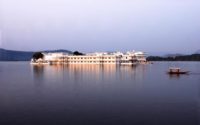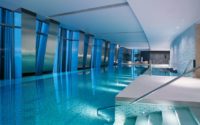The best palace hotels of Rajasthan
Here is a list of 22 of the most luxurious heritage hotels in Rajasthan where you can vacation like a maharaja when you are in India.
Vacation is a time of relaxation and calm. It is a time when one likes to immerse oneself in luxury and relax, enjoying a break from work. Spending time with family, taking time for yourself and traveling to an unknown land while learning about its history and culture. That describes the perfect vacation.
With its status as a state with a living history, Rajasthan is the perfect place to spend your vacation. The state is marked by its distinctive culture, beautiful desert landscapes and some of the best preserved and maintained forts, havelis, stepwells and heritage structures that the country has to offer.
A vacation in this state will allow you to enjoy the same comforts of an Indian king. Here is a list of 22 of the most luxurious heritage hotels in Rajasthan, where you can vacation like a maharaja.
Rajmahal Palace, RAAS, Jaipur

Built in 1729, the Rajmahal Palace has long been the residence of the royalty of Jaipur. In 1821, it underwent an Art Deco transformation and became the residence of the British resident of Rajputana. Having long been the residence of Maharaja Sawai Man ‘Jai’ Singh and Maharani Gayatri Devi, the palace receives special mention in the Maharani’s memoirs, “A Princess Remembers”.
The palace has been renovated by interior designer Adil Ahmed to become the luxurious heritage hotel of today. Rajmahal Palace Hotel offers you the opportunity to share the same royal experience as the famous visitors to the palace, such as the Kennedys, the British Royal Family and the Shah of Iran.
Marble staircases, period interiors and original royal artifacts will make your stay at the Rajmahal Palace unique. The hotel has 13 rooms and suites furnished with a combination of family heirlooms and artifacts, some of which are even named after famous visitors who stayed there during their visits.
You can stay in the Kennedy, Mountbatten and Princess of Wales. The rooms are equipped with luxurious amenities and beautiful décor that will make you feel like a Maharaja.
RAAS Rajmahal Palace offers a blend of Indian and international cuisines in three restaurants: The Colonnade, 51 Shades of Pink and Orient Occident. The Polo Bar, an ode to polo in Tiffany blue, offers a litany of local and international cocktails, wines and spirits.
RAAS Rajmahal offers its guests many experiences around the hotel: visiting Johri Bazaar, shopping at Narain Niwas Palace, visiting other heritage sites like Hawa Mahal Palace, Amer Fort and City Palace.
Rambagh Palace, Jaipur
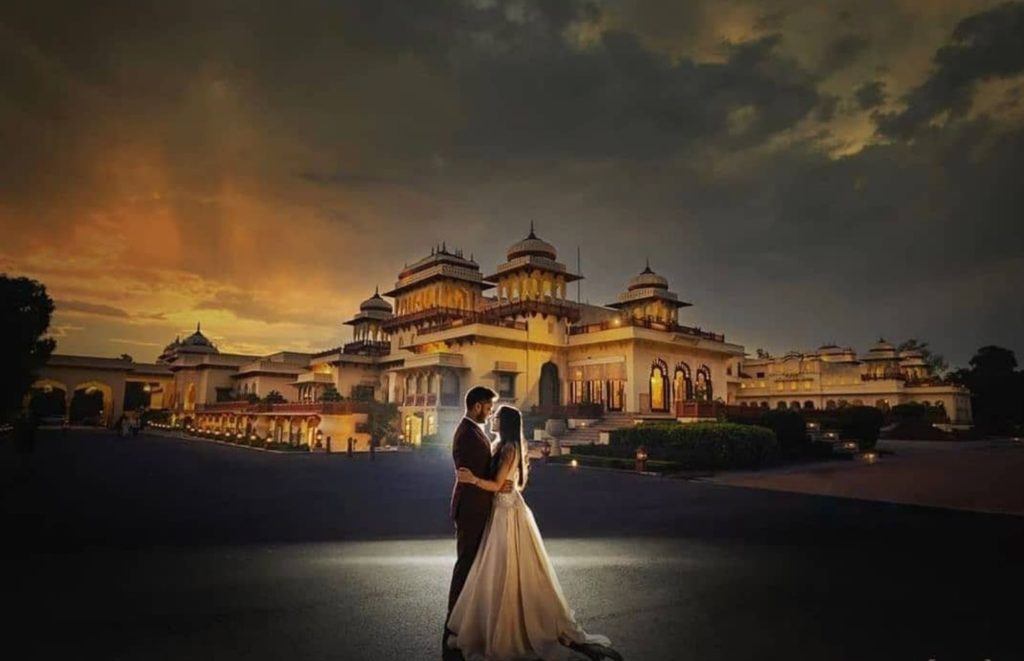
Once the residence of the Maharaja of Jaipur, the Rambagh Palace is now a hotel run by the Taj Hotels Group. The palace was first built as a garden house in 1835. In 1887, it was converted into a hunting lodge and was expanded into a palace in the early 20th century. Finally, Maharaja Sawai Man Singh II made Rambagh his main residence in 1931.
Today, it is a hotel with 78 suites, chhattris, hand-carved marble trellises, Mughal gardens and sandstone balustrades. Accommodation at the hotel includes rooms with garden and courtyard views. The Grand Presidential Suite is the largest suite in the hotel, with a private lounge overlooking the courtyard, a private terrace, a royal dining room and a master bedroom. All rooms are equipped with state-of-the-art amenities to ensure the best in contemporary luxury. The hotel has hosted a number of celebrities, royalty and politicians.
Dining at Rambagh Palace is a royal affair. The Suvarna Mahal is the perfect place to enjoy a royal Indian feast in the palace’s former ballroom, built in 18th century French style. The Rajput Room, an all-day restaurant, offers a more varied multi-cuisine menu. The Verandah Café also offers a multi-cuisine menu. Enjoy cocktails at the Steam Lounge or the Polo Bar, a polo-themed bar decorated with memorabilia and trophies of the Jaipur polo team.
You can get a massage at the Jiva Grande Spa, indulge in unique culinary experiences at the Hawa Mahal, Gazebo, Heritage Wing or elsewhere. The Hawa Mahal is an extraordinary place to dine. You can also take heritage walks around the palace to learn about its history and grandeur.
Samode Palace, Jaipur

The palace was built as a fort in the 16th century, but was later transformed into a palace in the early 19th century by Rawal Berisal, with influences from Muslim and Rajput architecture. The palace is located near the village of Samode, at the foot of the Aravali Hills. The sandstone structure features the ancient Rajasthani interior style with marble floors, ornamental pillars, mosaic walls and ancient murals.
The hotel has hosted celebrities, artists, royalty and travelers. Today, it is a testament to Rajput grandeur and contemporary hospitality and luxury. Accommodation at the palace is varied, with each room seemingly having its own personality. Each royal suite is a luxury apartment with private courtyards overlooking the mountains and a private Jacuzzi. Each room has beautiful wooden furnishings, white linens, carved sofas and four-poster beds.
Dining at Samode Palace is an experience in itself. Breakfast is served in the open-air courtyard, evening cocktails are usually served by the pool, and the terrace garden is the place to be for dinner reservations. The Palace’s wine cellar offers an exquisite selection of local and international wines to accompany your dishes.
Activities at Samode Palace include a guided tour of the hotel, massages and therapies at the hotel spa, and workouts at the fitness center. You can also visit the Mughal gardens at Samode Bagh, go on a horse or camel safari and visit the dunes, or shop at the local market in Samode village.
Amanbagh, Ajabgarh
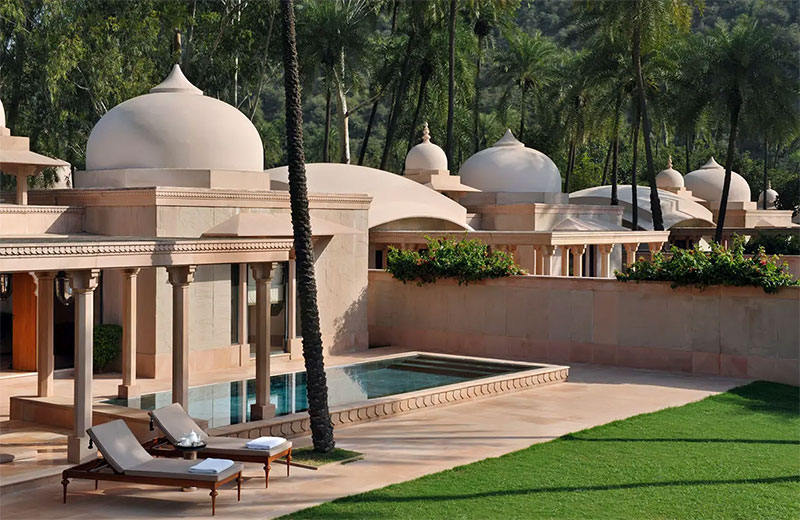
This complex, located in a walled oasis, is a testimony to the Mughal architecture of Rajasthan. It is located in a remote area in the Aravali Hills of Rajasthan, steeped in history for centuries. From the beginnings of Hindu history to the glory of the Rajputs to the conquest of the Mughal emperor Shah Jahan in the 17th century, Amanbagh has seen it all.
The complex stands on the site of the walled compound used by the Maharaja of Alwar for his tiger hunting camps in the Aravali Hills. The area is lush with greenery and provides water and nutrients to a nearby lake. A vacation at this place will rejuvenate your soul and make you one with nature. The resort is a modern creation that strives to preserve the old by offering contemporary comfort in traditional architecture and design.
Amanbagh’s suites are a haven of peace surrounded by fruit trees and flowering shrubs, and further on, by the arid Aravali hills. Depending on which ones you choose, the suites have private pools, terraces and courtyards. All offer a regal experience in their palatial beauty and grandeur.
Dining at Amanbagh is an adventure in delectable flavors and health. The food is rich with the flavors of North Indian cuisine and the benefits of Ayurvedic cooking. Local dishes prepared according to recipes handed down from generation to generation feature prominently on the menu. In addition, the resort offers local pan-Indian specialties, all prepared with local ingredients and locally grown medicinal herbs.
Culinary experiences at Amanbagh include cooking demonstrations and private dining at beautiful venues such as the Pool Pavilion, Rooftop Chhatri, Jhilmil Bada, and breakfast or lunch at Bhangarh.
You can also visit the ancient ghost town of Bhangarh, Somsagar Lake, Sariska Tiger Reserve or Ajabgarh Fort.
Alila Fort Bishangarh, Jaipur
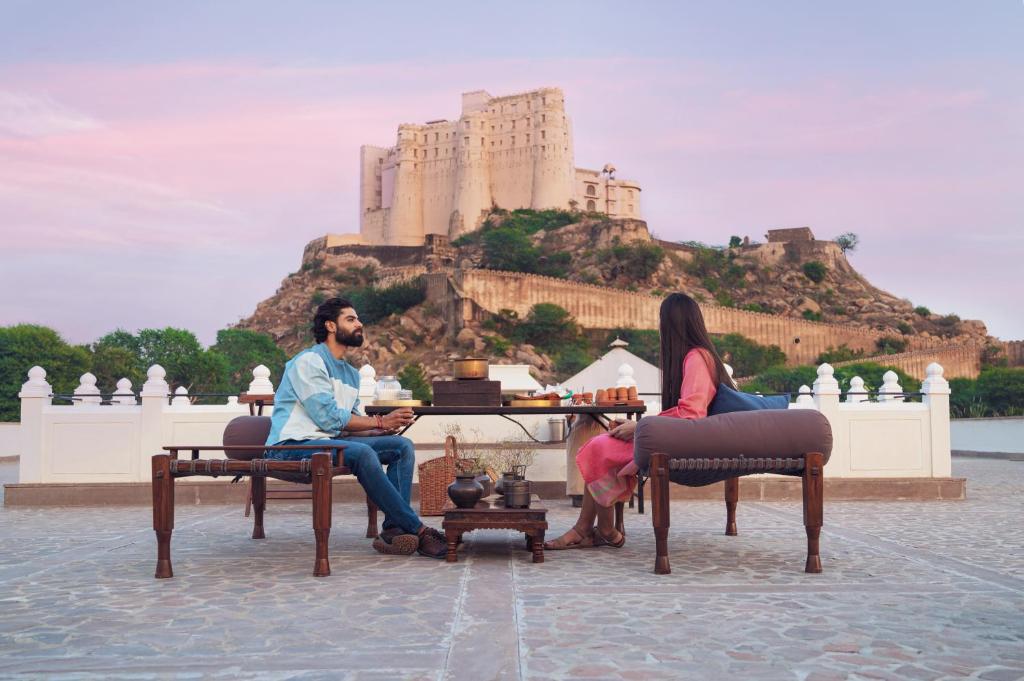
The resort is located just 6 km from the Delhi-Jaipur highway and is designed in harmony with the environment. The hotel aims to offer contemporary luxury while preserving the natural beauty of the area. The restoration of the fort has been achieved through traditional Rajasthani construction techniques using local stones and contemporary architecture.
The fort, located atop a granite hill in the Aravali range, is a 230-year-old warrior fortress that has served as the residence of several kings. The design of the hotel is a testament to the Gharana architecture of Jaipur, with Rajput and Mughal influences. The style is clean and austere, with clean interiors marked by Rajasthani elements. Jharokhas, stone lattices, brass panels and hand-printed fabrics are common features.
Alila Fort Bishangarh has 20 large suites, 18 heritage rooms, 11 royal suites, eight king suites and one presidential suite. The rooms are all equipped with luxury amenities and state-of-the-art technology to make your stay as pleasant as possible. In addition, the presidential suite has a private terrace.
Four restaurants make up the dining experience at Fort Bishangarh. The first, Amarsar, is a Silk Road-inspired specialty restaurant serving Thala breakfast, a la carte breakfast and international menus for lunch and dinner. Second, Nazaara is an evening service restaurant specializing in Shekhawat and Bishangarh cuisine and Rajput hunter’s cuisine. Third, the Madhuveni is the bar and restaurant where you can enjoy whiskey blends, cocktails and cigars. Finally, the Haveli is the poolside boutique restaurant with a Mediterranean menu.
Experiences include a Rasoda Rajasthani master class, a spa and wellness center, private dining, tours of local artisan stores and a walk to the 500-year-old Hanuman Temple near an ancient dam on the Madhuveni River.
Samode Haveli, Jaipur
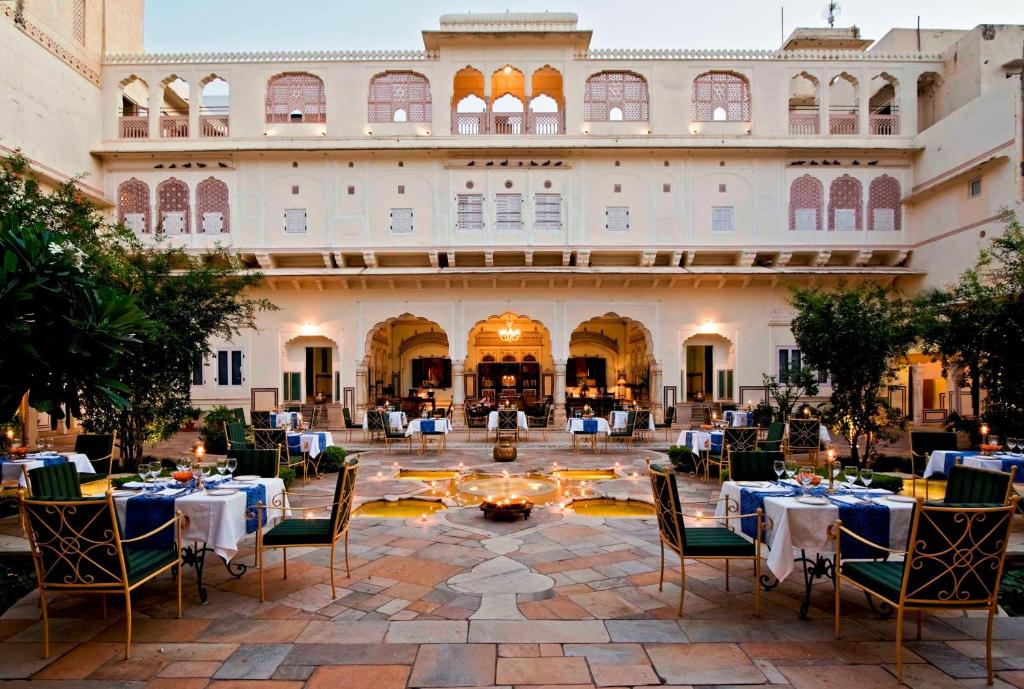
Originally designed by the Rawals of Samode nearly 225 years ago, the Haveli has since been the home of the rulers of Samode. Today, the Haveli is still owned by the descendants of the original rulers who have transformed it into a luxurious hotel. The Haveli is a traditional Indian mansion with decadent gardens and apartments arranged around different courtyards. The Haveli has undergone many additions over the years, which gives it a special charm.
The former royal residences have been converted into suites to give you a royal experience. The Haveli hotel suites feature contemporary amenities and old world antiques. Hand-painted frescoes adorn the walls of the restaurant, which was once the dining room of the Haveli.
The restaurant offers a combination of local Rajasthani flavors and international cuisines. You can choose to have afternoon tea in the veranda lounge and enjoy cocktails and dinner by the pool.
The experiences at Samode Haveli are as exquisite as its interiors. The Samode Haveli offers something for everyone, from morning walks in Jaipur to safaris in Jhalana Park, bike rides and massages at its state-of-the-art spa.
RAAS Jodhpur
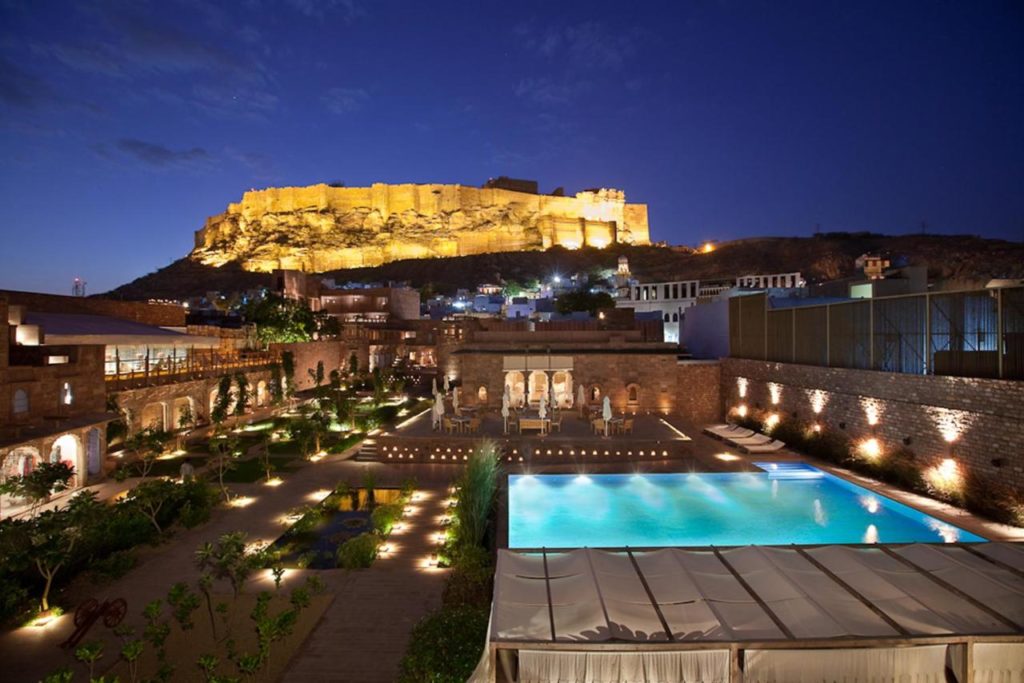
RAAS Jodhpur is situated around an 18th century Haveli overlooked by the Mehrangarh Fort, 400 feet above the Jodhpur skyline. The hotel includes four original buildings and three contemporary structures that were inspired by the walled city. The new additions are modern in their approach (in terms of space and light) but remain rooted in tradition.
The former Haveli’s guest house, the Darikhana, is the hotel’s most popular dining venue. The Baradari, the Thakur’s personal entertainment pavilion built in the 1850s, is another dining venue and, as in the original, hosts various events.
RAAS Jodhpur has five restaurants, all of which offer exceptional views of the Mehrangarh Fort and feature contemporary Western and authentic Rajasthani cuisine. You can choose to dine at Baradari, Darikhana or Stepwell Cafe, which overlooks the stepwell and serves lunch and dinner, with refreshments and cocktails.
The suites at RAAS Jodhpur combine historic Rajput grandeur with sleek contemporary design, all in spacious rooms with luxury amenities. Hotel experiences include Ossian expeditions, family activities, Mehrangarh Fort and Jodhpur city tours.
WelcomHeritage Bal Samand Lake Palace, Jodhpur
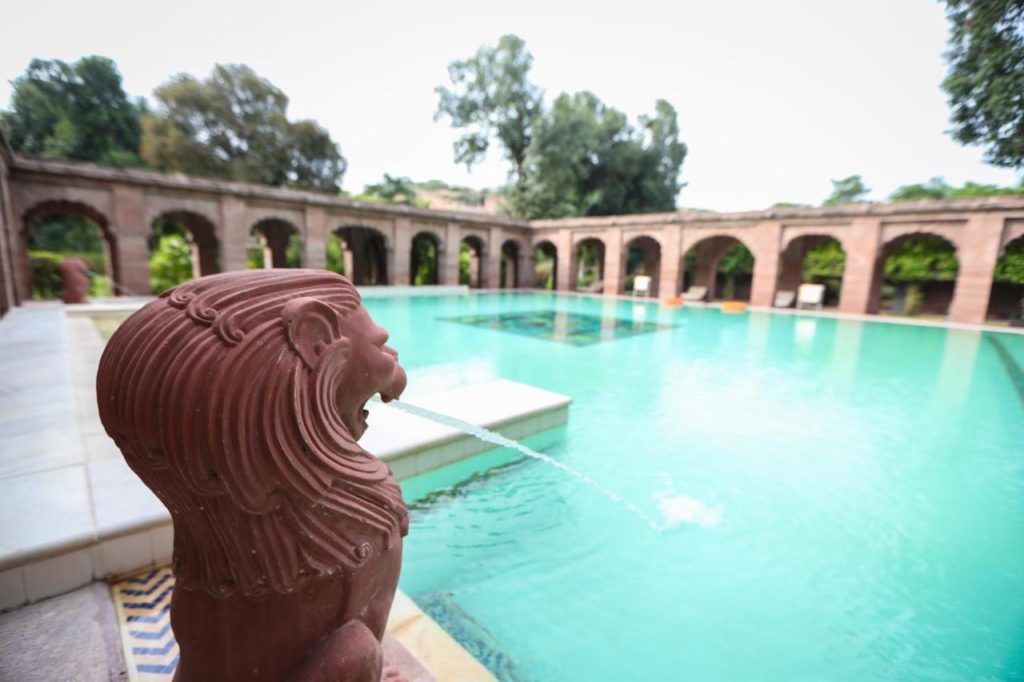
Just 5 km from Jodhpur is a lake named Balsamand. The lake was designed as a water basin in the 12th century to provide water to the inhabitants. In the 17th century, Maharaja Jaswant Singh I of Jodhpur added a red stone palace on the lake shore. The Bal Samand Lake Palace is today converted into a heritage hotel. The palace is situated on a 60-acre private estate, with orchards, manicured lawns and flower gardens.
Guests can choose from 26 garden suites, 9 royal suites and a Maharani suite. The Bal Samand Lake Palace Hotel has five restaurants. They include the Garden Restaurant, Kebab Corner BBQ, Bar Lounge cocktails and Lake View Restaurant panoramic views. You can even request a themed dinner at the restaurant if you want to experience royalty.
The hotel has an obstacle course and offers various other activities such as bird watching, horseback riding, royal buggy rides, horseback safaris and village safaris. The hotel also offers excursions to various sites in Jodhpur like Umaid Bhawan Palace, Mehrangarh Fort, Maha Mandir and Guda Bishnoiyan.
Umaid Bhawan Palace, Jodhpur

Umaid Bhawan Palace, one of the largest private residences in the world, is an iconic structure in Jodhpur that was built between 1928 and 1943. The palace was built by Maharaja Umaid Singh, the 37th Maharaja of Marwar in Jodhpur. The palace was commissioned after the Maharaja was approached by the farmers of the region who were suffering from severe drought and famine in the 1920s. The construction of the palace, which provided employment opportunities for the farmers, was led by architect Henry Vaughan Lanchester. The architectural style of the palace is Beaux-Arts.
Today, part of the place is managed by Taj Hotels, such as the Umaid Bhawan Palace Hotel in Jodhpur. The hotel’s location on top of Chittar Hill offers exquisite views of the blue city, Mehrangarh Fort and the nearby dunes. The Palace Hotel has hosted many international and local celebrities and has also been the venue for a celebrity wedding. The hotel offers a range of suites and rooms decorated in the 1970s Art Deco style.
The culinary experience at Umaid Bhawan Palace is second to none. You can enjoy authentic Indian and Rajasthani cuisine at Risala or savor more European and Mediterranean delights at Pillars. Cocktails and cigars at Trophy Bar are a great way to unwind in a hunting-themed setting. Experiences include heritage walks, rejuvenating massages at the spa, and museum tours on history and architecture.
Rawla Narlai, Jodhpur

Located in the shadow of Elephant Hill, Rawla Narlai is a 17th century hunting mansion owned by the royal family of Jodhpur that has been restored to its original state. Today, it houses the hotel, which caters to an exclusive clientele for a charming getaway. The mansion is lush with open spaces and interiors that have been specially designed to ensure your comfort. The hotel has managed to preserve much of its original glory and offers a glimpse of the rich country manor lifestyle.
Located between Jodhpur and Udaipur, the hotel has a lot to offer, both on-site and nearby. The hotel’s rooms include heritage suites, deluxe heritage suites and the Narlai suite. In addition, the hotel offers a variety of unique experiences. When you stay at a hunting mansion, a jungle tour is a must.
At Rawla Narlai, you can choose to incorporate a high tea into your jungle trip and enjoy it while watching leopards. You can also take a sunset walk on the elephant hill or visit the various sites in and around Narlai. Dinner at the Rampart includes a 16th century staircase, earthen lamps, folk music and traditional Rajasthani cuisine. You can also enjoy a wide variety of classic and house cocktails.
RAAS Chhatra Sagar, Pali
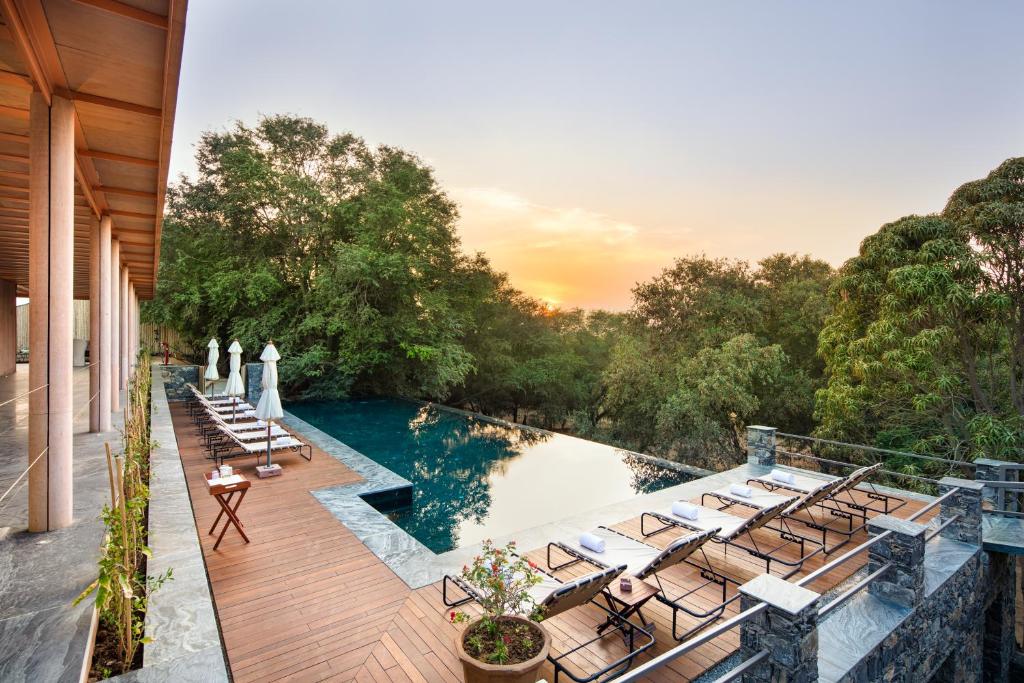
Based on the historical concept of Rajput luxury caravans, RAAS Chhatra Sagar is a luxury camp along the reservoir of Nimaaj village in Jaitaran. The luxury tents offer all the comforts that a luxury hotel can provide – spaces with air conditioning and heating make RAAS Chhatra Sagar one of the only camps of its kind in the country that remains open all year round.
The tents are equipped with contemporary furniture and muted colors to help you feel comfortable and in tune with the surrounding nature. Walkways provide a private space outside the tent to enjoy the idyllic view with your thoughts or loved ones. Chhatra Sagar, known for its diverse birdlife, is home to nearly 200 species of birds that can be seen from any part of the camp.
The camp has 16 luxury tents – four family tents and 12 deluxe tents. Each tent is equipped with luxury amenities and offers beautiful panoramic views of the reservoir and countryside.
Dining at Chhatra Sagar is literally a feast. The all-day dining restaurant offers a wide variety of authentic Rajasthani, Indian and international dishes. In addition, the bar offers a litany of cocktails, both alcoholic and non-alcoholic. RAAS offers aperitifs, bird watching, village and farm excursions, nature safaris, private cooking sessions with the chef and even bird watching on a boat.
Chanoud Garh, Pali
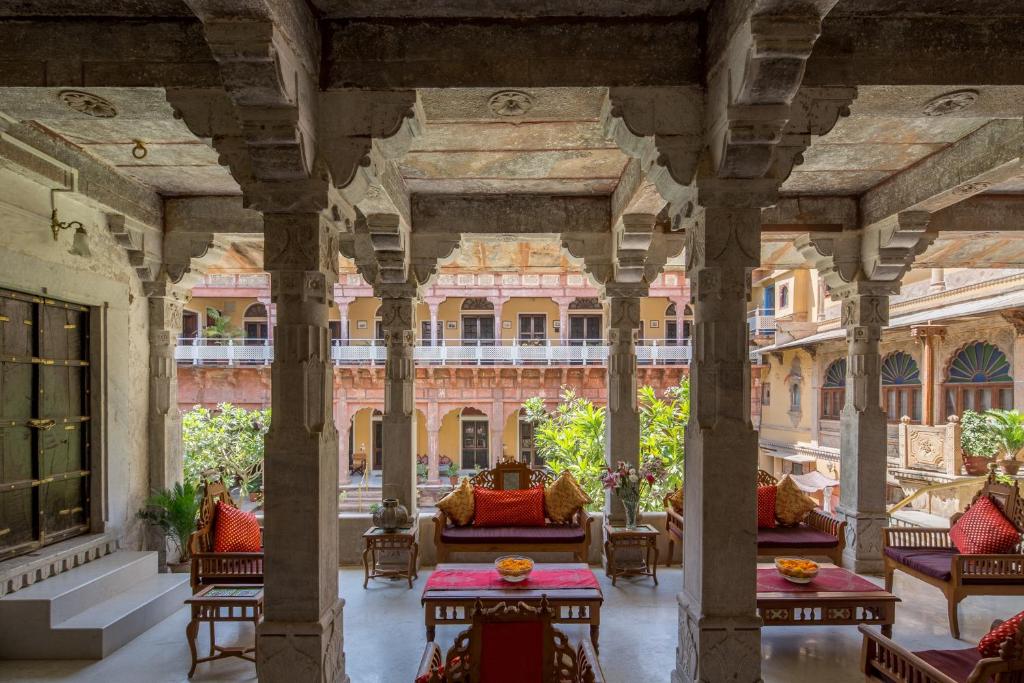
The Chanoud Garh fort is a 300 year old palace that stands like an oasis in the Thar Desert. The fort has been meticulously restored and is now a heritage hotel. The fort was commissioned by Thakur Anoop Singh Ji and has been managed by the same family for 13 generations. It is spread over an area of 200,000 square feet and features typical Rajput architecture.
The palace has magnificent marble pillared corridors, stone Jharokhas, courtyards and lawns. The present royal family, headed by Patriarch Thakur Ajeet Singh Ji, resides in a closed wing of the palace. The family is the host and manager of the Chanoud Garh.
The hotel has ten suites furnished with antique and contemporary furniture. The rooms are decorated with family heirlooms, and the décor is reminiscent of the grandeur of Rajasthan. All rooms have a private sitting area, and some are reminiscent of Victorian architecture built during the colonial period.
Dining at the Garh is an exquisite affair. The Moti Mahal is the main dining room. Decorated with the original vegetable dye paintings, it is the perfect place to have your breakfast. The Badal Mahal is the terrace with dinner service for summer nights. The Thakur itself hosts the communal dinner service, which moves to Mor Chowk with bonfires in the cold winter. The Garh serves traditional recipes passed down from generation to generation and prepared with local ingredients. The Thakurani herself presides over the kitchen, making it a truly royal affair.
The experiences at the Chanoud Garh are like no other. Apart from the leopard safari, the hotel offers a heritage walk and the opportunity to celebrate various Hindu festivals like Teej, Diwali, Holi with your family. You can dress up in complementary traditional outfits and join the prayer ceremony presided over by the family priest in the family temple. You can then take part in all the celebrations. You can also take a walk through the village with the retired school director of Chanoud Village, passing by historic temples and artisan stores.
Suján Jawai, Pali
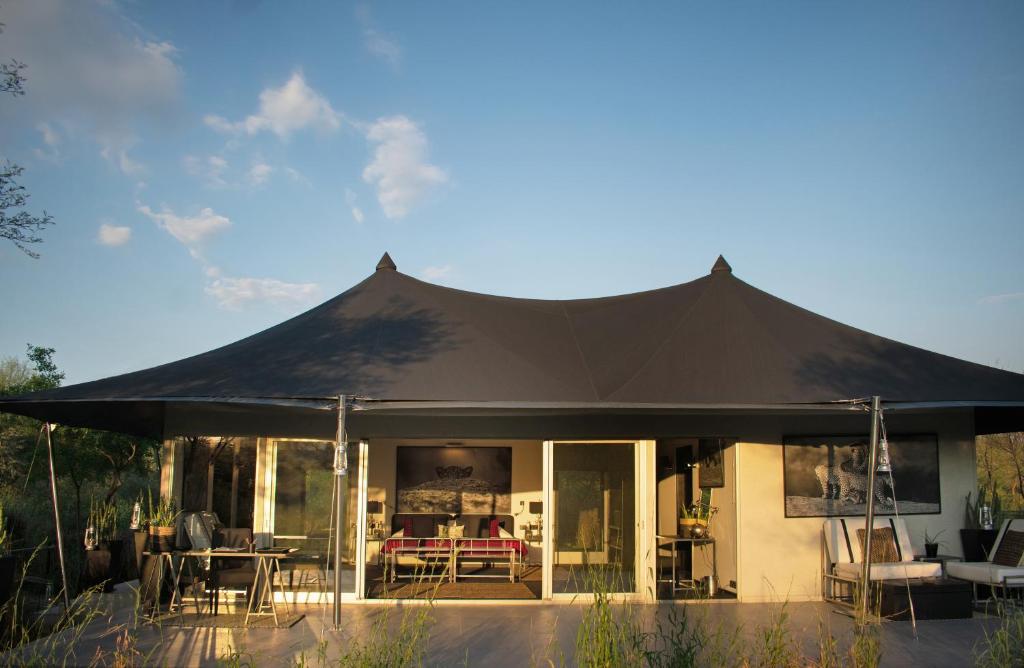
Established in 2014, Suján Jawai is a peaceful haven amidst granite rock formations and wilderness where another majestic jungle cat, the leopard, lives. Here you will be surrounded by Aravali hills, grasslands and sandy riverbeds, all to explore. In addition, you can walk with the local Rabari herders for an unparalleled cultural immersion.
The luxury camp has ten luxury suites, including a “Panthera” king suite and a “Felidae” family suite. The camp blends comfort and luxury with panache, and oddly enough with a contemporary industrial style using brushed steel furniture and a black and white color palette. The red you see around you, both on the ground and in the pops of color in the camp and its decor, represents the Rabari shepherds.
Each tent has a large veranda where you can sit and enjoy the scenery of Jawai Bandh. The Panthera Royal Suite, with its private heated pool and dedicated butler, is the perfect place if you prefer privacy and luxury.
The dining at Suján Jawai is an amalgam of local and contemporary. The food is prepared using local produce and fresh ingredients from local farmers. The dining tent allows you to watch your food being prepared in its live kitchen, and you can still enjoy your meal in a private and secluded area.
Safaris are the focus of the resort, but the experiences at Suján Jawai are unique: you can walk with the Rabari herders, take a guided tour of the local villages, or hike around the camp in the surrounding fields or up one of the many hills in the area.
Mihir Garh, Rohet
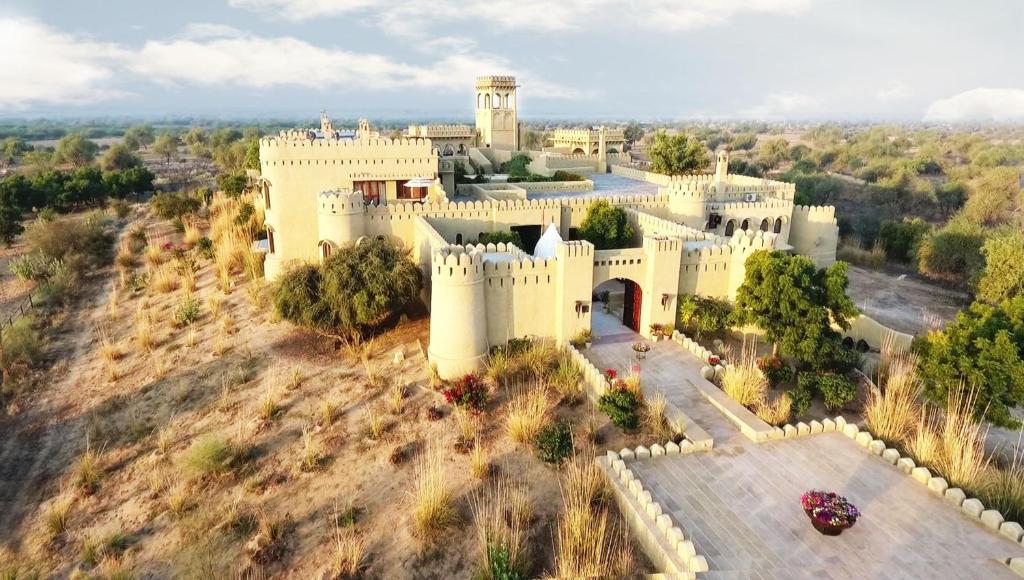
A desert hotel celebrating Rajasthan, Mihir Garh is located in Rohet against the backdrop of the vast Thar Desert. It is inspired by the rural architecture of Rajasthan and is known as the “fortress of the sun”. Mihir Garh is owned and managed by Thakur Sidharth Singh, the 14th Thakur Saheb of Rohet and Double Tazimi Siryat of Jodhpur. One hundred local craftsmen and carpenters built the hotel under the supervision of Thakurani Sahiba Rashmi Singh. It is located on “Mali Nathji ka Dhora”, the sacred dune dedicated to the warrior god hero of Mewar.
The fort has nine suites. Each suite has an area of 1700 square feet, with Jacuzzis or private pools. The Alishan suites are located on the first floor and offer a private courtyard and infinity pool. The suites located on the upper floor are called the Shandaar Suites and offer a private Jacuzzi and a private terrace. Each suite features modern amenities and fireplaces handcrafted by villagers from nearby villages.
The dining experience at Mihir Garh is very personal; food is prepared according to your taste, and the establishment offers several cuisines, local, pan-Indian and international. Their specialty, however, is Rajasthani cuisine. Breakfast is served by the pool, lunch in the room or in the tent, and dinner in a beautiful dining room with hand-painted interiors.
Hotel experiences include village safaris, Shikar dinners with elements of Rajput hunting cuisine, royal lakeside picnics after safaris, an equestrian program and culinary workshops on Rajasthani cuisine.
RAAS Devigarh
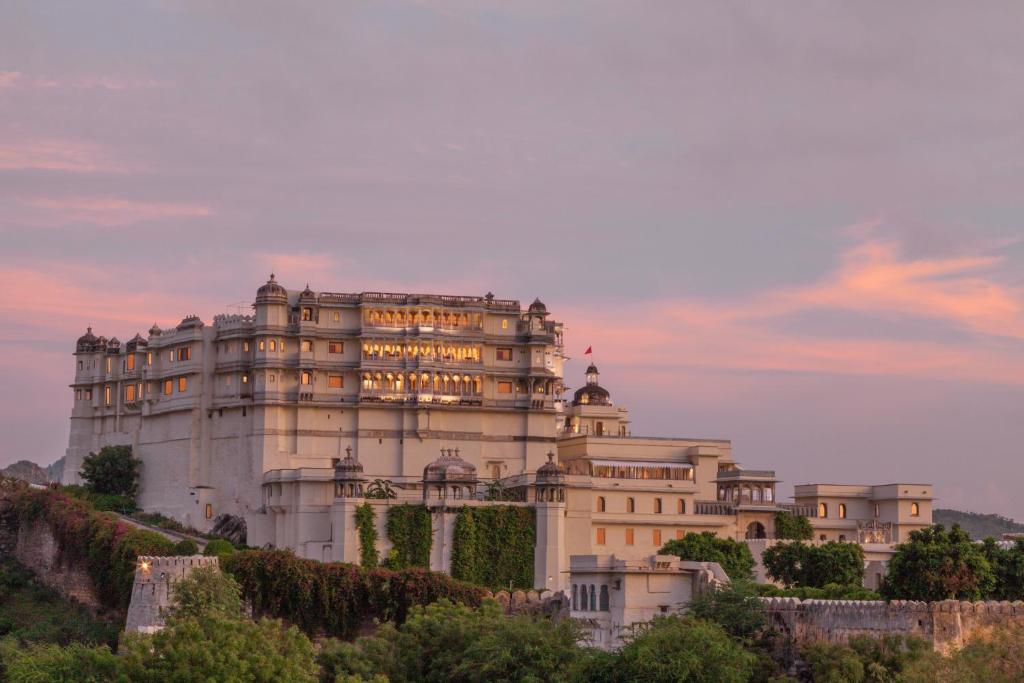
Built in 1760 during the reign of Rajrana Sajja Singh II and situated on a hilltop in the Aravali range, RAAS Devigarh is a sight to behold. RAAS Devigarh overlooks the village of Delwara. The fort is located 45 minutes away from the city of Udaipur.
The history of this fort goes back further than the year of its completion. The principality of Delwara was given to Rajrana Sajja Singh I and his brother Ajja Singh by Maharana Pratap of Mewar for their services after the battle of Haldighati in 1576. The fort was restored two centuries later over a period of 15 years by a team of 750 people led by architects Gautam Bhatia and Navin Gupta.
The hotel opened its doors to visitors in 1999, offering an amalgam of ancient and modern. RAAS Devigarh has hosted many celebrities like Amitabh Bachchan, Fardeen Khan, the Ambanis and Liz Hurley. It is known as one of the best designed hotels in India.
The hotel has 39 suites that combine the ancient beauty of the fort with contemporary 21st century luxury. You can choose to stay in the luxurious Palace and Aravali suites, which offer magnificent views and evoke the Rajasthan of old. Or you can choose to stay in the more modest Garden Suites, which offer simplicity with their garden views and outdoor patios. The Devigarh complex is the most luxurious, with its private terrace, Jacuzzi and private black granite pool.
Experiences at the fort include a heritage walk through Delwara, a trip to the top of Sajjan Garh, excursions to the temples of Chittorgarh and Sawaryaji, and a visit to the museum to learn about the Battle of Haldighati.
Taj Lake Palace, Udaipur
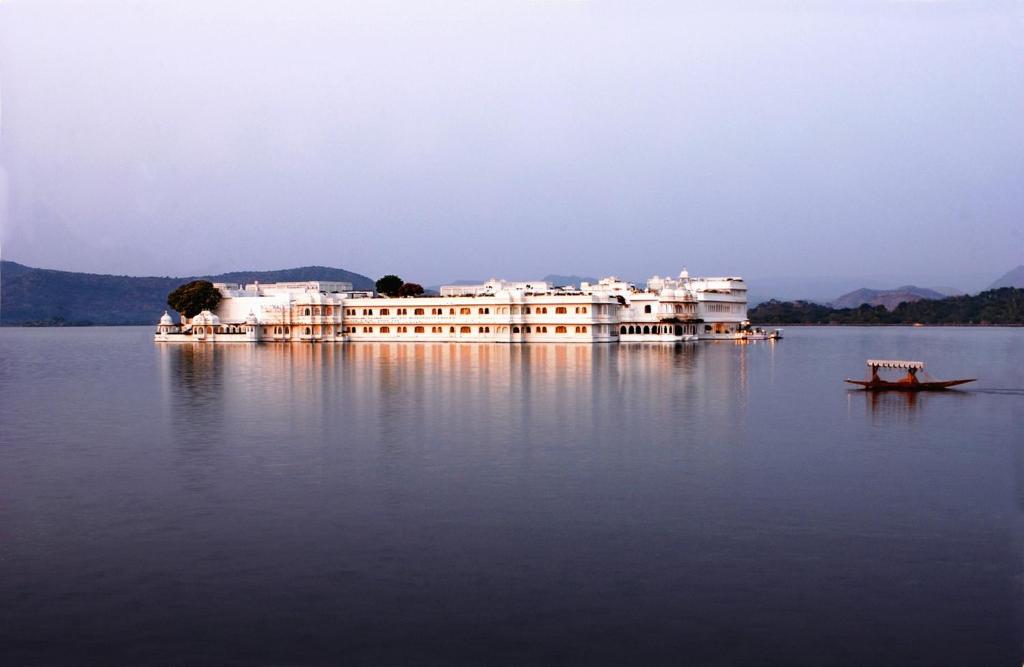
The Lake Palace is located on the island of Jag Niwas in Lake Pichola in Udaipur. Once the summer palace of the royal Mewar dynasty, the palace is now run as the Taj Lake Palace Hotel. It was built between 1743 and 1747 under the direction of Maharana Jagat Singh II of Udaipur. The walls of the palace were built with black and white marble and are decorated with semi-precious stones. It also has many courtyards, all lush with gardens, fountains, terraces and columns.
The palace was transformed in 1969 by Maharana Bhagwat Singh into India’s first luxury hotel, and in 1971 Taj Hotels took over the management of the hotel. The hotel has hosted several dignitaries, including Queen Elizabeth, the King of Nepal, Jacqueline Kennedy, Vivien Leigh and Lord Curzon.
The hotel has 65 luxurious rooms and 18 grand suites, all flanked by stunning views of the lake, City Palace, Aravali Hills, Machla Magra Hills and Jag Mandir.
Four restaurants serve the hotel’s residents. For traditional Rajasthani and North West Frontier cuisine for dinner, Neel Kamal is the place to go. Bhairo offers an exquisite menu of contemporary European cuisine, while Jharokha is a multi-cuisine option. Amrit Sagar is the hotel’s bar that offers a selection of wines, spirits and cigars. It also serves Asian cuisine and tapas. Finally, the Jiva Spa is the hotel’s favorite place for massages. It also offers heritage walks, unique culinary experiences and boat rides after cocktails.
Taj Fateh Prakash Palace, Udaipur
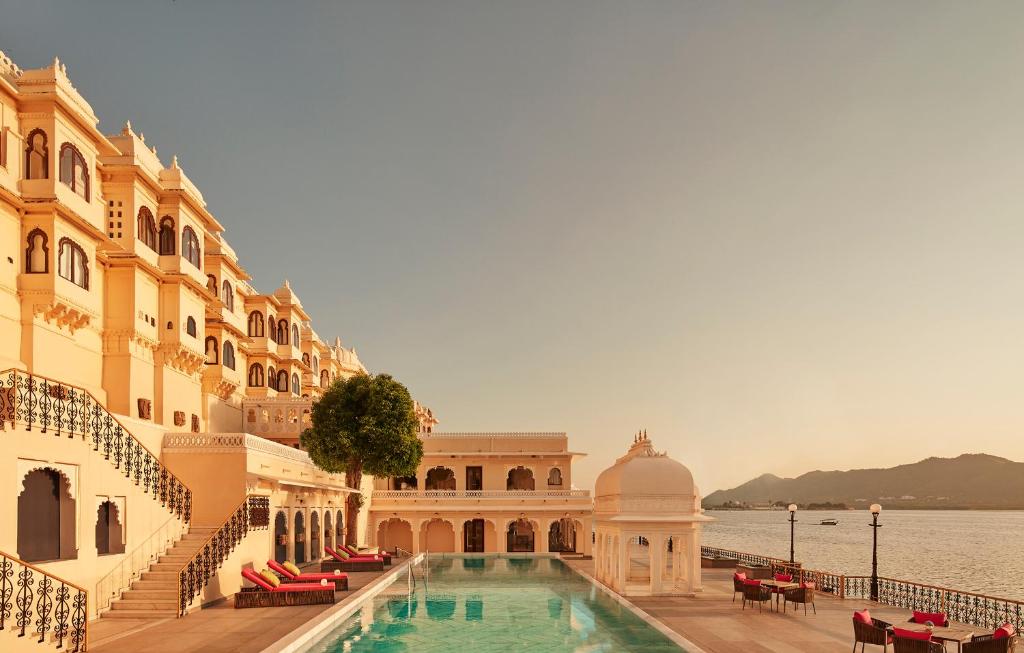
Taj Fateh Prakash Palace is located on the eastern shore of Lake Pichola and is part of the City Palace complex. Built in the 20th century by Maharana Fateh Singh to host royal events, the hotel now has 65 rooms and suites spread over two wings.
The hotel is adorned with period artifacts, miniature paintings, crystal chandeliers, Persian carpets and period mahogany furniture. The palace is a blend of Rajasthani and Mughal architecture and retains its original glory by keeping its original interiors and grandeur.
You can choose to stay in the deluxe suite or the palace room. The deluxe suite, grand deluxe suite and royal suite are other options for your stay. In addition, the hotel offers you the opportunity to enjoy a multi-cuisine menu at Sunset Terrace. The restaurant serves local Mewari cuisine and other pan-Indian and international dishes while offering a magnificent view of the Lake Palace complex.
The Suryadarshan Bar is the perfect place to enjoy afternoon tea while admiring the beautiful sunset views in Udaipur. Unique experiences include exclusive boat cruises, tea at Nazar Bagh and private dining at Rang chowk in the fort.
Oberoi Udaivilas, Udaipur
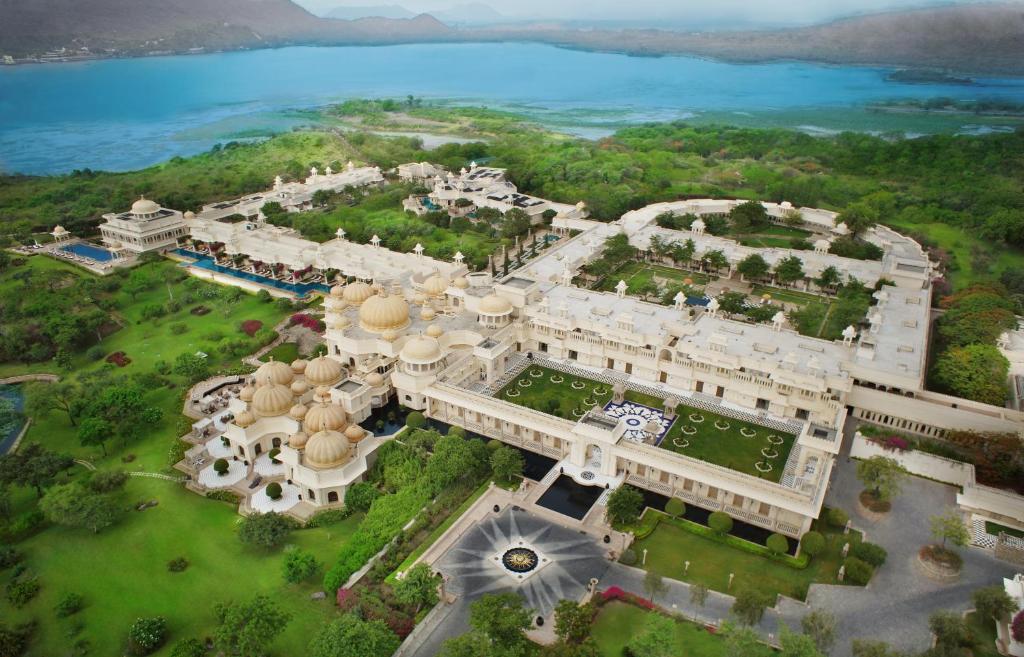
Probably one of the best hotels in India, the Oberoi Udaivilas is a luxury resort built on the 200-year-old hunting grounds of the Maharana of Mewar. Nearly half of the 30-acre property is a designated nature reserve. Designed by architect Nimish Patel and his partner Parul Zaveri, the structure features Mewari architecture, with large domes, cupolas and Chhatris. The entire hotel premises are creamy white and lush, with large courtyards, gardens, fountains and reflection pools.
The hotel has 90 rooms and five suites. Each room has a garden area with a patio, and some even have a private infinity pool. You can choose from a first-class room with a garden view, a first-class room with a semi-private pool and lake view, a deluxe suite with a private pool, or the Kohinoor Suite with views of the Aravalli Hills, Lake Pichola and the City Palace.
There are two dining options. The informal Surya Mahal and its adjacent open-air terrace, Chandni, offer all-day dining, views of the City Palace and Lake Pichola, and the chance to be transported to the colonial era of the 1930s. The Udai Mahal, the evening gourmet restaurant, offers Indian specialties, live music and a starry atmosphere under the painted domes at midnight. The bar is inspired by the Mewar and offers alcoholic coffees, iced cocktails, martinis, classic cocktails and house cocktails.
At Oberoi Udaivilas, you can dine on the Promenade, under the lakeside dome or in the lakeside pavilion. You can also get a massage at the hotel’s spa, learn to cook from the chefs, participate in a private yoga session with a personal trainer, learn the art of miniature painting or take a heritage walk. The hotel also offers a variety of activities for children, a professional astrologer and the opportunity to watch artisans create inlaid glass tiles in the Thekri workshop.
Suján Sher Bagh, Ranthambhore
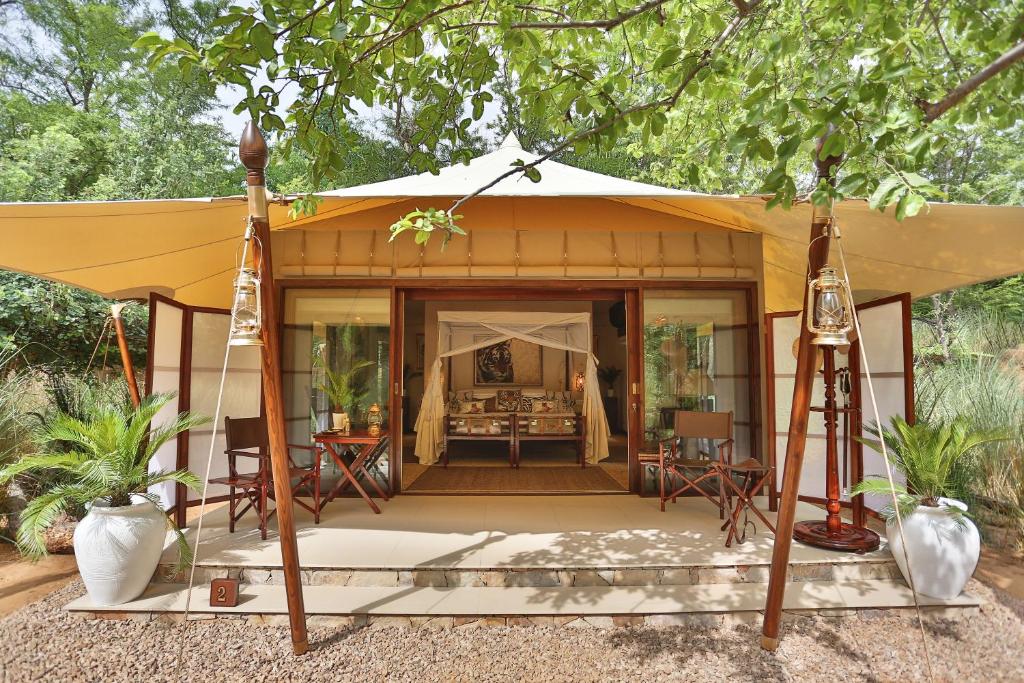
The Sher Bagh luxury safari camp is located on the edge of the Ranthambhore Tiger Reserve. Reminiscent of a colonial-era hunting expedition, the camp is an eco-friendly camp that promotes sustainable tourism. The land, part of the Suján family’s conservation efforts since 1974, was once the hunting grounds of the Maharajas of Jaipur.
Today, they house 12 luxury tents and two suites, all of which evoke the charm of the 1920s colonial era. The furniture, made of teak and rosewood, has a lot to do with it. It will make you feel like an English nobleman or an Indian royal on a jungle expedition to watch the majestic tiger.
You can choose to stay in the jungle tented suites, whose luxury and state-of-the-art facilities offer both comfort and privacy. The Royal Sher Suite is the right suite for you if you prefer to be alone on your jungle expeditions. This two-bedroom suite has its own garden, private heated pool and outdoor fireplace. The Imperial Suite “Raj Bagh” is known for its spacious interiors and for being the place where friends and family can party while surrounded by nature.
Dining options at this Ranthambhore mecca range from Anglo-Indian and European lunches to traditional Indian dinners cooked in open-air clay ovens, all with organic ingredients grown on site. In addition, you can visit the Sher Bagh spa, go on safari or take a jungle cooking class. You can even hike the Ranthambhore Fort or shop at the chic safari boutique, all at Suján Sher Bagh.
Six Senses Fort Barwara, Ranthambhore

Overlooking Barwara Lake, Chauth ka Barwara Temple and located 22km from Ranthambhore National Park, Six Senses Fort Barwara is the newest heritage hotel on this list. It opened in October and is a three-hour drive from Jaipur.
The resort is the result of a conservation effort to revive the royal charm of ancient Rajasthan. The complex includes two palaces, two original temples and 48 suites within the walls. The landscape retains the traditional gardens and water features. It faces the village of Barwara to the west and to the east, a beautiful and quiet forest.
The fort was built by the Chauhans in the 14th century and was taken by the Rajawat dynasty from the Hadas in 1734. Today it is owned by Prithviraj Singh, who played a central role in the restoration efforts along with landscape designer Savita Punde and horticulturist Pradeep Kishen of Sunder Nursery in New Delhi. The suites were designed in what can be described as a contemporary Rajasthani style. They integrate state-of-the-art technology with the ancient grandeur of the fort.
You can choose to stay in the Sanctuary, which offers a view of the inner garden and the fort wall, or in one of the Fort Suites, which offers a view of Barwara village or the lake, or in the Burj Suite, which offers a view of the lake, Chauth ka Barwara temple and the Aravali range. The resort has an extensive library, a store and an on-site personal trainer.
The restaurants at Fort Barwara are varied: Rajasthani restaurants offer a combination of Rajasthani and pan-Indian cuisine, with international influences. Dishes are prepared with local and seasonal ingredients. Dining options include dinner at Cortile, next to a 14th-century courtyard, Roohani (the Indian specialty restaurant) or Rani Bagh. You can also head to the observation gallery for an exquisite selection of wines or the Rajawat Room for delicious cocktails.
You can watch the sunset over the Aravali Mountains, take a heritage walk, go on a safari in Ranthambhore and take a spiritual journey through the hotel’s temples. You can also visit the hotel’s spa, take a cooking class, go for a morning hike and picnic outside, or take a cultural walk through the nearby villages.
Narendra Bhawan, Bikaner
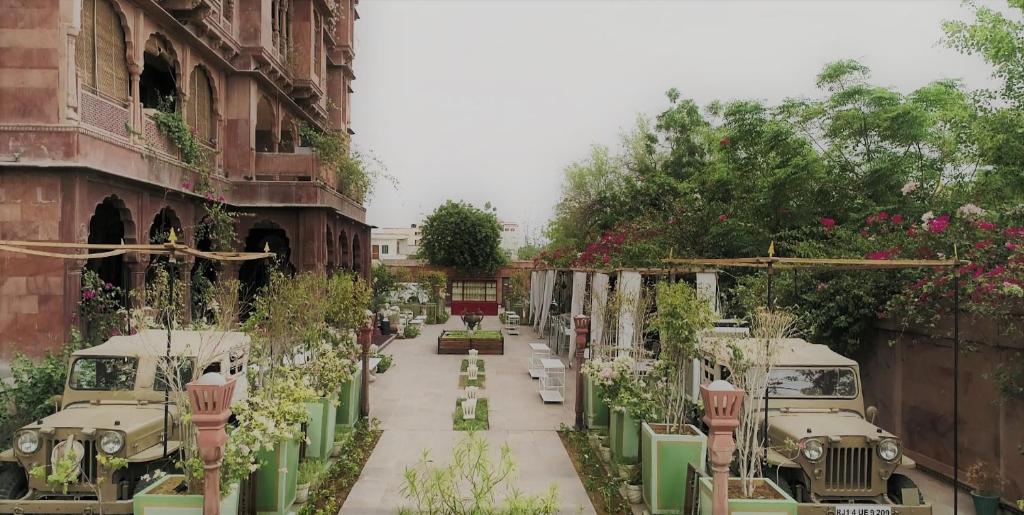
Narendra Bhavan is the living memory of Narendra Singhji’s travels around the world. The Bhawan is a testimony to the growth and influence of his travels on the original residence. It has been designed on the theme of blending contemporary India with India of the past to create a unique experience.
The design of the palace is inspired by the Art Deco movement and royal military academies, as well as Broadway glamour stations. The palace consists of the Gaushala (cowshed), located right at the entrance. This stable is a tribute to Lord Krishna and the Veranda, Diwali Chowk and several other charming places that create an amalgam of modern and traditional.
The Bhawan has 53 suites to choose from. The residence rooms are a tribute to the eclectic tastes of the house, with their Portuguese tiles and English color palette, while the prince’s rooms are a glimpse of Western influences on the king’s life, with their English prints and mosaics. The regimental rooms, Indian rooms and the Republic suite all reflect their themes and the Maharaja’s eclectic choices.
Dining at the Narendra Bhawan is served in three restaurants: P&C, the elegant dining room featuring the favorites of the Bikaner royal family, Gaushala with a menu of small snacks and cocktails, and Durbaar Hall. The Mad Hatter – The Bake House is the hotel’s bakery offering traditional confections and baked goods.
Experiences at Narendra Bhawan include sunset appetizers, the Crescent Grill Diner, dinner at the museum, the Night Room, and a private outdoor dinner overlooking the beautiful desert.
Suján The Serai, Jaisalmer

Founded in 2008, Suján The Serai is a desert camp located on a 100-acre private estate in the Thar Desert, an hour from Jaisalmer. The brand was created by conservationists Jaisal and Anjali Singh, who have had a deep connection to the region for nearly three generations.
The luxury camp is a sight to behold – inspired by the caravans of the Rajputs; local sandstone artisans handcrafted the camp’s amenities to create the walls, plunge pools, and the inverted step well serves as a view for the pool.
The Manganiyar folk music group provides live entertainment for the night, where they sing ancient songs that leave a lasting memory. The camp is both the desert and Jaisalmer – a colorful backdrop amidst the sandy, beige desert landscape.
The luxury camp houses 21 tents on sandstone bases and 14 tented suites, six deluxe suites and one royal suite. The deluxe suites are separated by private walls, while the royal suite has a perimeter wall, a personal butler, a private spa and a heated pool.
The Serai is an amalgam of modern and ancient. The dining tent is a place where everyone can share time to interact, or you can ask the staff to set up a dining table anywhere you like on the property. Food includes seasonal and local delicacies made from organic ingredients grown on site. Western options are also available.
The camp offers experiences such as visiting Jaisalmer, the 12th-century golden fortress, and exploring the bazaar with an expert guide.
–
Check our Travel Guides
